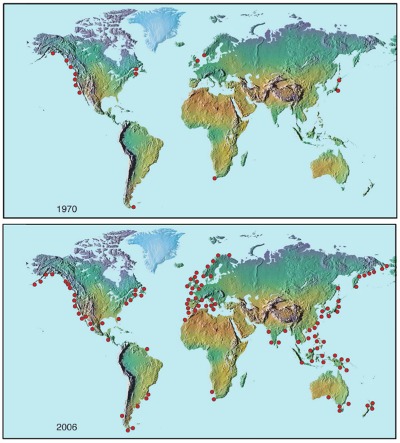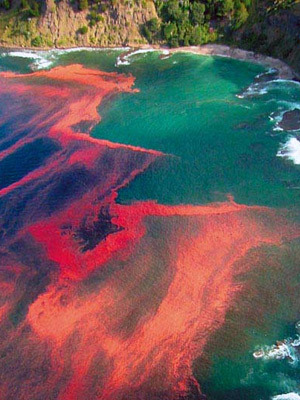
Habitat
Gonyaulax catenella thrives in the photic zones of the water
columns.
Because they use photosynthesis as a means of acquiring
nutrition, they must stay near the top. They prefer cooler
temperatures in coastal and open waters. The organism is
dispersed throughout their habitat by wind driven and tidal
currents. They can also move about the water column in response
to temperature and light. As shown on the map, outbreaks of this
organism has been found in waters along the north-east coast of
North America: Massachusetts, New Hampshire, and Maine; Nova
Scotia, New Brunswick, and Quebec in Canada; and along the
countries bordering the Northern Sea including Denmark, Germany,
Netherlands, Norway and the United Kingdom. They have also been
found in
© 2007 WHOI
use photosynthesis as a means of acquiring
nutrition, they must stay near the top. They prefer cooler
temperatures in coastal and open waters. The organism is
dispersed throughout their habitat by wind driven and tidal
currents. They can also move about the water column in response
to temperature and light. As shown on the map, outbreaks of this
organism has been found in waters along the north-east coast of
North America: Massachusetts, New Hampshire, and Maine; Nova
Scotia, New Brunswick, and Quebec in Canada; and along the
countries bordering the Northern Sea including Denmark, Germany,
Netherlands, Norway and the United Kingdom. They have also been
found in
© 2007 WHOI
the northern Atlantic coasts of South Africa, and New Zealand. Just recently has G. catenella been found to be poisoning waters near Japan.
Because they
 use photosynthesis as a means of acquiring
nutrition, they must stay near the top. They prefer cooler
temperatures in coastal and open waters. The organism is
dispersed throughout their habitat by wind driven and tidal
currents. They can also move about the water column in response
to temperature and light. As shown on the map, outbreaks of this
organism has been found in waters along the north-east coast of
North America: Massachusetts, New Hampshire, and Maine; Nova
Scotia, New Brunswick, and Quebec in Canada; and along the
countries bordering the Northern Sea including Denmark, Germany,
Netherlands, Norway and the United Kingdom. They have also been
found in
© 2007 WHOI
use photosynthesis as a means of acquiring
nutrition, they must stay near the top. They prefer cooler
temperatures in coastal and open waters. The organism is
dispersed throughout their habitat by wind driven and tidal
currents. They can also move about the water column in response
to temperature and light. As shown on the map, outbreaks of this
organism has been found in waters along the north-east coast of
North America: Massachusetts, New Hampshire, and Maine; Nova
Scotia, New Brunswick, and Quebec in Canada; and along the
countries bordering the Northern Sea including Denmark, Germany,
Netherlands, Norway and the United Kingdom. They have also been
found in
© 2007 WHOI the northern Atlantic coasts of South Africa, and New Zealand. Just recently has G. catenella been found to be poisoning waters near Japan.
Gonyaulax catenella has
adapted to cooler temperate waters so it can bloom
Red Tide.
In some unusual instances, G. catenella
bloom
Red Tide.
In some unusual instances, G. catenella
©M.Godfrey
red tide blooms have begun to grow in
warm waters around South America. To understand what changes and
modifications Gonyualux catenella has gone through to
survive as a thriving organism, follow the link to the
Adaptations page.
Take a peak at another marine organim, the
Irukandji Jellyfish .